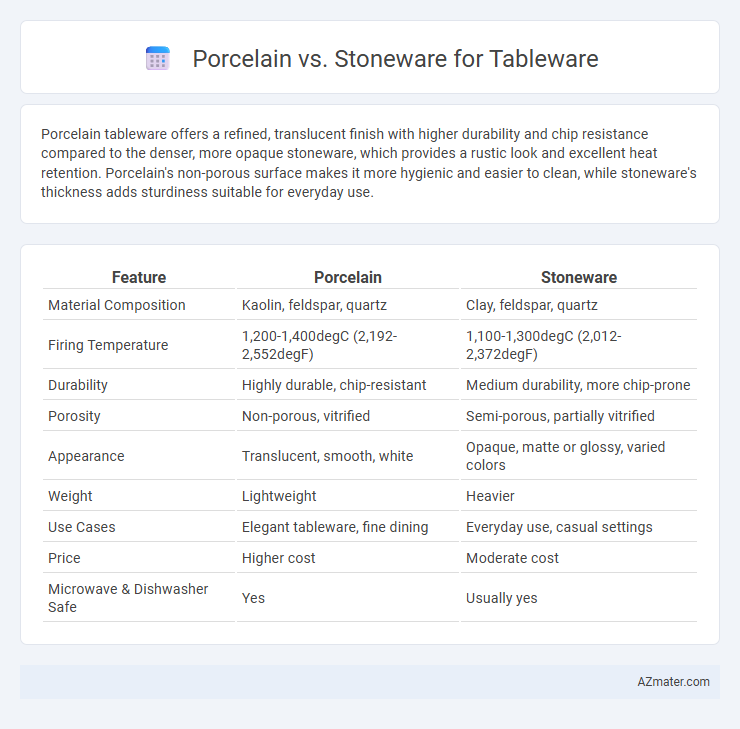Porcelain tableware offers a refined, translucent finish with higher durability and chip resistance compared to the denser, more opaque stoneware, which provides a rustic look and excellent heat retention. Porcelain's non-porous surface makes it more hygienic and easier to clean, while stoneware's thickness adds sturdiness suitable for everyday use.
Table of Comparison
| Feature | Porcelain | Stoneware |
|---|---|---|
| Material Composition | Kaolin, feldspar, quartz | Clay, feldspar, quartz |
| Firing Temperature | 1,200-1,400degC (2,192-2,552degF) | 1,100-1,300degC (2,012-2,372degF) |
| Durability | Highly durable, chip-resistant | Medium durability, more chip-prone |
| Porosity | Non-porous, vitrified | Semi-porous, partially vitrified |
| Appearance | Translucent, smooth, white | Opaque, matte or glossy, varied colors |
| Weight | Lightweight | Heavier |
| Use Cases | Elegant tableware, fine dining | Everyday use, casual settings |
| Price | Higher cost | Moderate cost |
| Microwave & Dishwasher Safe | Yes | Usually yes |
Introduction to Porcelain and Stoneware
Porcelain and stoneware are both popular materials for tableware, prized for their durability and aesthetic appeal. Porcelain is a type of ceramic known for its translucence, smooth texture, and high resistance to chipping due to its fine-grained composition and vitrification at high temperatures. Stoneware, on the other hand, is thicker and more opaque with a robust, dense body fired at slightly lower temperatures, offering excellent strength and a rustic, earthy finish ideal for everyday use.
Key Differences Between Porcelain and Stoneware
Porcelain tableware is characterized by its fine, translucent quality and high firing temperature of around 1,200-1,400degC, resulting in a durable, non-porous surface ideal for elegant dining. Stoneware, fired at slightly lower temperatures between 1,100-1,300degC, exhibits a denser, opaque structure with a more rustic, earthy appearance and greater chip resistance. Porcelain's smooth, glass-like finish contrasts with stoneware's thicker, often matte texture, making each suitable for different aesthetic and functional preferences in tableware.
Material Composition and Manufacturing Process
Porcelain tableware is made from a refined clay mixture containing kaolin, feldspar, and quartz, fired at ultra-high temperatures ranging from 1,200 to 1,400degC, resulting in a dense, white, and translucent finish. Stoneware consists of a blend of clay, silica, and feldspar, fired at slightly lower temperatures between 1,100 to 1,300degC, producing a more opaque, durable, and chip-resistant material. The manufacturing process of porcelain involves precise firing control to achieve its vitrified, glass-like surface, while stoneware's thicker composition provides robustness suited for everyday use.
Durability and Strength Comparison
Porcelain offers superior strength and chip resistance due to its high-firing temperature and dense, vitrified structure, making it ideal for elegant tableware. Stoneware, fired at slightly lower temperatures, provides robust durability with a thicker, more rustic finish that resists cracking and chipping under frequent use. Both materials are dishwasher and microwave safe, but porcelain's finer composition makes it less prone to abrasion and long-term wear compared to stoneware.
Appearance and Aesthetic Appeal
Porcelain features a smooth, translucent surface with a bright white finish that exudes elegance and refinement, making it ideal for formal dining settings. Stoneware offers a more rustic, earthy appearance with a matte or satin glaze that highlights natural textures and organic patterns. The aesthetic appeal of porcelain is polished and delicate, while stoneware brings a warm, handcrafted charm to tableware collections.
Heat Resistance and Microwave Safety
Porcelain tableware typically withstands higher temperatures up to 1400degC, making it excellent for oven use, while stoneware generally resists heat up to 1200degC but offers robust durability. Both porcelain and stoneware are microwave-safe, although porcelain's non-porous surface reduces the risk of moisture absorption, ensuring safer microwave heating. Stoneware may retain heat longer, suitable for serving hot dishes, but porcelain's fine grain and dense structure provide superior resistance to thermal shock.
Maintenance and Cleaning Requirements
Porcelain tableware requires gentle cleaning with non-abrasive cloths and mild detergents to maintain its smooth, glass-like surface and prevent scratches. Stoneware is more durable and resistant to chipping, allowing for easier maintenance with regular dishwashing and less concern for wear over time. Both materials are dishwasher safe, but porcelain benefits from hand washing to preserve its fine finish, while stoneware's porous texture may need thorough drying to avoid moisture retention.
Price and Value Considerations
Porcelain tableware generally commands a higher price due to its fine, translucent quality and durability, offering long-term value for those seeking elegance and resistance to chipping. Stoneware provides a more budget-friendly option with a sturdier, rustic appeal that is less prone to scratching but can be heavier and less refined in appearance. Choosing between porcelain and stoneware depends on balancing aesthetic preferences with budget constraints and the intended frequency of use.
Best Uses for Porcelain Tableware
Porcelain tableware excels in formal dining settings due to its elegant, translucent appearance and resistance to chipping and cracking. Its non-porous surface makes it ideal for serving delicate sauces and fine cuisine, ensuring easy cleaning and stain resistance. Porcelain is best suited for occasions requiring sophistication, such as weddings, upscale restaurants, and special celebrations.
Ideal Applications for Stoneware Tableware
Stoneware tableware excels in everyday use due to its durability and resistance to chipping, making it ideal for family meals and casual dining settings. Its dense, non-porous surface withstands frequent washing and temperature changes, which supports microwave and dishwasher safety. The rustic, handcrafted aesthetics of stoneware also enhance farm-to-table restaurants and cozy home kitchens seeking both functionality and style.

Infographic: Porcelain vs Stoneware for Tableware
 azmater.com
azmater.com